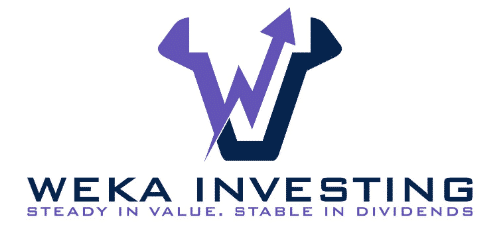Are you in search of a safe and dependable approach to construct your wealth and produce income? Dividend investing is one of the most favored tactics for attaining financial autonomy. Through dividend investing, it is possible to reinvest dividends from stocks into added shares of stock, thus escalating your passive earnings with time. Additionally, by embracing a core-satellite plan concerning dividend investing – implying combining both competitive and cautious investments – you can lessen risk while possibly earning higher returns. In this blog post, an investigation will be conducted regarding the fundamentals of dividend investing along with basics on stock market investment strategies that focus on core-satellite plans as well as which stocks are ideal for income investors.
Understanding the Basics of Dividend Investing for Income
Dividend investing is one of the wisest approaches to accumulate wealth and generate earnings via investment in the stock market. The notion behind dividend investing is straightforward – buying shares of a company which distributes dividends, or a portion of its profits, to stakeholders. In return for owning these stocks, shareholders are provided with regular payments from that business by way of dividends. These disbursements can either be utilized as an additional income source or reinvested into more stocks so as to further grow investments.
In relation to dividend investing, there are two specific strategies – value and growth investing. Value investors center their attention on buying stocks at a price cheaper than that which they consider as its true worth, whereas growth investors search for stocks with the probability of significant capital appreciation in the future. Both approaches may be successful when it comes to dividend investing for income though each carries its own advantages and disadvantages which should be taken into consideration prior to making any investment decisions.
A significant advantage of dividend investing is the greater stability it offers compared to other stock market investment methods. This is because, even in times where share prices are volatile or dropping, companies still commonly pay out dividends. Thus, investors who have a portfolio that takes a hit due to changing markets benefit from having an additional source of income. Moreover, reinvesting those dividends instead of cashing them out instantly can lead to compounded returns on investment over time and considerable profits in the long run.
Dividend investing for income provides many advantages, not the least of which is its tax efficiency. Qualified dividends are typically taxed at a lower rate than other forms of investment income such as interest payments from bonds or capital gains taxes resulting from selling stocks for more than they were originally purchased (known as short-term capital gains). This makes them attractive investments within retirement portfolios looking to benefit from tax advantages.
Overall, having an understanding of basic principles behind investing with dividends can help make informed decisions about how best to reach financial objectives while taking advantage of benefits offered by this type strategy like opportunities for potential savings on taxes and enhanced stability through continuous cash flows regardless market conditions.
How to Start Income Investing in the Stock Market
Dividend investing for income in the stock market is an attractive choice for those seeking to generate a reliable source of income. Investing in stocks can prove quite profitable, so long as one has knowledge of the associated risks and preparedness to embrace them. For some, beginning their journey into income investing on the stock market may appear intimidating; however it does not have to be that way. With proper research and education, anyone can start with assurance.
Gaining an understanding of how stocks operate and the kind of risk one is comfortable taking on must be the initial stage when setting out to partake in income investing. Through owning shares, individuals possess part ownership of a firm that distributes dividends based on their earnings or deficits over time. Generally speaking, organizations will pay out dividend payments for each share owned by shareholders; these are usually supplied quarterly or yearly depending upon the company’s capability and choices set forth by its board members.
When selecting stocks for dividend investing for income, it is important to prioritize those companies with a track record of consistent dividend payments that can yield good returns in the long run; this will ensure one has access to a steady stream of income which may be beneficial from financial perspective. Furthermore, comprehension and evaluation of volatility level – gauging how much the price fluctuates over time – must also take place when considering which stocks should be purchased.
Generally speaking, higher volatility implies more risk and potential for greater rewards, while lower volatility entails less risk but also a diminished prospect of reward. It is up to an individual investor to decide what degree of hazard they are willing to assume when it comes time make investment decisions. One should bear in mind that correlation does not convey causation; simply because two investments appear correlated does not necessarily mean one will have any kind of influence on the other (i..e., if one stock goes up whereas the other descends). Prior to investing, thorough research ought be conducted so as all feasible outcomes may be understood prior before making any financial commitment into either an asset class or company/stock selection process.

Pros and Cons of Dividend Investing for Income
Dividend Investing for Income may serve as an effective way to generate income from stocks, since such payments offer a dependable source of revenue which can be utilized in order to make future plans. Although dividend investing has its benefits, it is also accompanied by certain drawbacks and risks; consequently, it is essential for one to weigh both the advantages and disadvantages if considering whether or not this form of investment strategy suits them. A major benefit associated with dividend investing is that there exists potential for steady income generation.
Quarterly or semi-annually, companies pay dividends to reward investors for their loyalty in the long run. This makes them an ideal choice for individuals who are seeking a dependable source of income they can count on yearly. Furthermore, some dividends may be classified as qualified dividends and thus may qualify for reduced taxes when given out through certified distributions from IRAs or other retirement accounts.
An additional gain is that dividend remunerations habitually amplify with the passing of time as enterprises turn more remunerative or raise their dividends due to superior levels of speculator assurance in their stock’s implementation and prospect. This provides investors the chance to generate an intensifying return on their investment without needing to jeopardize extra funds by purchasing further shares or reinvesting what they already possess into higher producing investments such as bonds or real estate investment trusts (REITs).
Disadvantageously, dividend investing tends to be less volatile in comparison with other forms of stock trading such as day or swing trading whereby returns (and losses) can transpire hastily and unexpectedly relying on short-term price shifts and transformations in market perception over time.
Consequently, those who are reliant on Dividend Investing for Income may be exposed to greater danger if there is an unforeseen alteration in company performance that causes a reduction or cessation of these payments entirely; this could significantly decrease any returns from the stocks held within their portfolio when markets experience substantial declines. Moreover , since several companies only give out dividends after meeting certain criteria concerning profitability levels , potential investors must vigilantly observe said conditions before making decisions about investing in particular stock .
Furthermore , although qualified dividend income possesses tax advantages , they might not always outweigh the costs associated with retaining specific stocks for long periods especially if such shares cannot compete effectively against other investments. Therefore, it’s essential to factor all possible outcomes into your decision-making procedure prior to determining whether this type investment strategy suits you best .
Importance of Investment Strategies for Income Generation
Investment plays an integral role in the lives of numerous individuals. Regardless of whether one is just beginning or has been investing for a while, it is critical to have a plan that will help them accomplish their monetary objectives. One popular strategy utilized by investors is dividend investment which necessitates buying stocks that distribute dividends; these are routine payments made to shareholders from company profits. Dividend investing can be an excellent method of generating income from one’s investments over time as long as done thoughtfully and tactically.
In order to be successful in dividend investing for income, it is important to carefully choose stocks that provide steady and consistent dividends. This requires doing research into the companies being considered for investment so as to gain an understanding of their financial performance over time, which can assist with predicting future dividends accurately. Furthermore, diversifying one’s portfolio by incorporating multiple types of investments is vital in order to reduce risk while simultaneously maximizing returns on invested capital.
Additionally, when selecting investments for their portfolio it is essential that investors research individual stocks as well as consider macroeconomic trends such has inflation rates, global economic conditions, political stability and currency fluctuations which can all affect stock prices and dividend payments over time. Setting up a system to monitor changes in market conditions helps identify appropriate action should the need arise; this practice is just one component of an effective investment strategy necessary for generating income from the stock market via methods like value or growth investing. To increase chances of successful outcomes whilst building an income-generating portfolio , individuals must take into account not only quality stocks but also factor in upfront research potential investments along with diversifying wealth across multiple holdings – moreover they must make sure to review these positions regularly .
Exploring Different Types of Investment Strategies
In terms of dividend investing for income, there are a plethora of strategies at an investor’s disposal. Each strategy features its own set of merits and demerits that can be adjusted to meet the individual requirements and objectives. Some widely-used investment tactics contain dividend investing, income investing, stock market trading, as well as index funds.
Dividend investing for income is a system in which stocks with recurrent payouts are acquired; these dividends may take the form either cash or shares within the company itself
The advantage of dividend investing for income is that it offers a steady stream of income without requiring active trading or portfolio management in the stock market. Moreover, many companies offer tax benefits for investors who hold their stocks over extended periods. Income investing is another popular investment strategy which centers on generating consistent returns through investments in high-yield bonds and other revenue-generating securities such as Real Estate Investment Trusts (REITs).
Unlike dividend investing which pays out only once in a year, income investments tend to provide investors with numerous chances for regular cash flow throughout the year compared to other types of investment. Stock market trading involves acquiring shares from publicly listed companies that have the potential of capital growth over time as well as dividends if applicable. Although there is no guarantee when it comes to stock market trading, this type of venture may offer prospects depending on how judiciously an investor makes choices concerning their portfolio or stocks. Lastly, index funds present a cost-effective way for gaining exposure toward specific parts of the stock exchange without having personally manage one’s own fund or selecting individual stocks because they are passively managed and posses diversification benefits arising from Exchange Traded Funds (ETFs). Moreover, these resources deliver comprehensive coverage across various sectors while also providing lower fees than customary mutual funds resulting ultimately into more savings for you!
The Core-Satellite Approach to Dividend Investing
Many investors utilize the core-satellite approach to dividend investing for the purpose of increasing their profits from stock trading while decreasing general risk. This strategy involves combining a combination of main investments, which may include dividends stocks and bonds, with satellite investments that could be constituted by higher yield securities or other income producing plans. Generally speaking, the core section usually contains renowned firms that have had an extended record of paying out uniform dividends in addition to gradually boosting them over time. These particular shares are often referred as “quality” or “safety” stocks since they deliver steady returns with little volatility.
The Satellite portion of a portfolio may comprise higher yield securities or other income-generating strategies like options trading and Real Estate Investment Trusts (REITs). By combining these two types of investments, an investor can attain balance between diversification and the generation of revenue without overextending risk in any single area. When putting together such a portfolio, it is paramount to keep one’s individual investing objectives in mind so as to guarantee that allocations are fit for purpose with regards to that particular situation. For instance, if seeking more short term capital gains then attention might be focused on high yielding investment vehicles including REITs or Master Limited Partnerships instead of dividend stocks which usually provide slow but consistent returns over time. It is also essential not only take into account existing yields when making selections within each category but additionally consider future prospects since some companies could offer potential growth both regarding price augmentation and enhancement in terms of dividends potentially resulting greater long-term profits thereafter.
Benefits and Risks of Core-Satellite Approach in Stock Market
The core-satellite approach to investing is a sound strategy for any stock market investor that involves the combination of different investment styles, such as growth or income, and utilizing a mix of asset classes. This tactic has several benefits in comparison with other types of stock market investing strategies; however there are also potential dangers associated with it.
One significant advantage offered by the core-satellite approach is that investors can craft portfolios which have diversified risk profiles while still being able to capitalize on possibilities in various markets and sectors.
By merging together both growth and dividend investing for income into a single portfolio, investors can construct an equilibrium of investments that is able to award them with capital increase along with dividend incomes without depending solely upon any individual asset grouping or sector for their whole return outline. Moreover, by including external assets such as alternatives trading or sector ETFs, investors may potentially amplify their yields by taking strategic stands in particular sectors while still preserving diversification inside the overall portfolio. Yet, there are certain potential risks tangled up in this manner of investing too.
Investors ought to be cognizant of the risks associated with investing too heavily in one sector or asset class, as unexpected drops in prices due to macroeconomic conditions or geopolitical events can lead to significant losses. Furthermore, investors should bear in mind that certain strategies such as options trading might not be appropriate for all types of investors given its inherent complexity and leverage involved. Moreover, implementing too many different strategies simultaneously could create a highly intricate portfolio which may make it hard for an investor to remain aware of their investments over time; this lack of proper monitoring and oversight management system has the capacity ultimately bring about costly mistakes on behalf of said investor.
Ways to Maximize Income Through Dividend Stocks
Dividend investing for income with stocks is an excellent strategy for investors to maximize their income. Companies which have chosen to pay out a portion of profits as dividends are those known as dividend stocks, providing shareholders with regular payments simply for owning the stock regardless of whether its price rises or falls. As such, it can be seen that individuals looking to gain a steady stream of revenue may find this type of stock particularly attractive.
In regards to dividend investing for income with stocks, it is essential to ponder aspects such as the firm’s stability (such as we find with the long-lasting dividend aristocrats) and development prospects, along with the magnitude and regularity of dividends distributed. Generally speaking, enterprises that have a history of providing consistent dividends are more dependable investments than those which deliver higher yields yet may not have been paying them for an extended period.
It is likewise imperative to examine what amount of cash you will really get from each stock; some stocks may have higher yields however in the meantime compensate you with lower sums since they are exchanging at lower costs per share than different organizations. Moreover, speculators should also remain mindful of their assessments when putting resources into profit paying stocks; certain sorts of profits are burdened contrastingly and seeing these distinctions can help financial specialists settle on more educated choices about which ones they ought to put resources into. At long last, it is essential to diversify your portfolio by holding various kinds investments including fixed-income items like bonds just as value ventures like regular stock or common assets so that if one kind performs inadequately there is still potential for benefit from another sort inside your portfolio total.
Tips on Choosing High-Dividend Yielding Stocks
When it comes to dividend investing for income in the stock market, dividend-yielding stocks can provide investors with a great opportunity for generating consistent income. These types of stocks are ones that pay out money in the form of dividends on a regular basis, typically quarterly or annually; thus providing individuals with an ongoing source of revenue and helping them diversify their portfolio. Nevertheless, selecting high-dividend yielding stocks is not necessarily straightforward as there may be numerous factors to analyze.
To begin this process effectively one should first undertake research into both the company’s history and its financials.
It is essential to understand the length of time for which a company has been paying dividends, as well as if they have increased or decreased in that period. Furthermore, its earnings history and current debt levels should be taken into account when making an informed assessment on how reliable future dividend payments may be. Yield rate must also be considered during selection of high-dividend yielding stocks; although higher yields could suggest more risky investments, this factor will need to balance with other considerations before deciding what stock would constitute a suitable addition to one’s portfolio. Moreover, any tax implications associated with different types of dividends ought not to remain overlooked at year end so as not to incur further costs than necessary. Ultimately it is important consider whether individual stocks are appropriate for one’s goals and risk tolerance level before investing – otherwise alternative options such mutual funds or ETFs that specialize in dividend-paying securities might prove useful instead; by allowing access multiple companies without needing choose them individually yet still providing potential returns via dividend payments .
Role of Financial Advisors in Creating a Balanced Investment Portfolio
Financial advisors are a fundamental aspect of investing, particularly in the context of fabricating an even investment portfolio. Putting money into the stock market can be incredibly intimidating and complicated; however, with assistance from an experienced financial advisor, individuals may confidently invest their funds without difficulty. When formulating portfolios for clients, financial advisors take numerous issues into account including gauging risk uptake capacity, examining current as well as future objectives , assessing cash flow needs and constructing a proper asset distribution methodology.
When constructing an asset allocation strategy for clients, financial advisors take into account both dividend investing for income and income-producing investments such as bonds and CDs. Dividend investing involves purchasing stocks that provide regular dividends from companies with a long history of making consistent payments to shareholders. This type of investment furnishes investors with steady returns while additionally helping to reduce overall volatility in their portfolios because its risk levels are comparatively lower than other forms of stock market investments like day trading or speculation on stocks.
Income-producing investments such as bonds and CDs offer an additional degree of security by providing more forecasted returns than equities, without increasing risk exposure over extended periods. Furthermore, financial advisors assess each individual client’s present circumstances in order to build a portfolio that will satisfy their specific objectives and hazard profile while also taking into account upcoming aspirations down the line like retirement planning or university savings plans for offspring or grandchildren.
Furthermore, financial advisors will take into consideration the economic conditions at different stages of an investor’s life cycle to adjust allocations accordingly so as to maximize returns whilst managing risk all through their lifetime journey in capital markets. Subsequently, a customized portfolio can be designed by these professionals for each individual client which offers a balanced combination between dividend investing strategies and income producing instruments such as bonds and CDs; this eventually assists them in attaining their desired return goals along with decreasing risks associated therewith.
In conclusion, dividend investing for income can be a great method of producing income while still comprising only part of an overall well-rounded investment strategy. The core-satellite approach is an advantageous way to diversify investments and reduce risk in the stock market simultaneously enabling potential gains. This plan provides investors with the opportunity to develop a revenue portfolio including exposure to various asset classes and strategies for making investments. Through proper planning, investing in dividends has shown itself capable of increasing one’s earnings as well as building wealth overtime.
Are you seeking the most recent information about dividend investing for income and updates concerning our company? Sign up for our newsletter today to remain current! Our newsletter is packed with helpful data and exclusive offers that are only accessible to subscribers. Through subscribing, you will gain insight into upcoming sales, special promotions as well as other exciting news. Additionally, we shall keep you apprised of all new products and services so that nothing goes unnoticed by you! Consequently, what do you have to lose? Join us now in this journey of progress while signing up!

Dr. Lincoln C. Wood teaches at the University of Otago in New Zealand. He is an avid investor and educator. He loves cash flow, income, and dividends when investing. He likes to buy undervalued companies with strong advantages and earnings growth.







